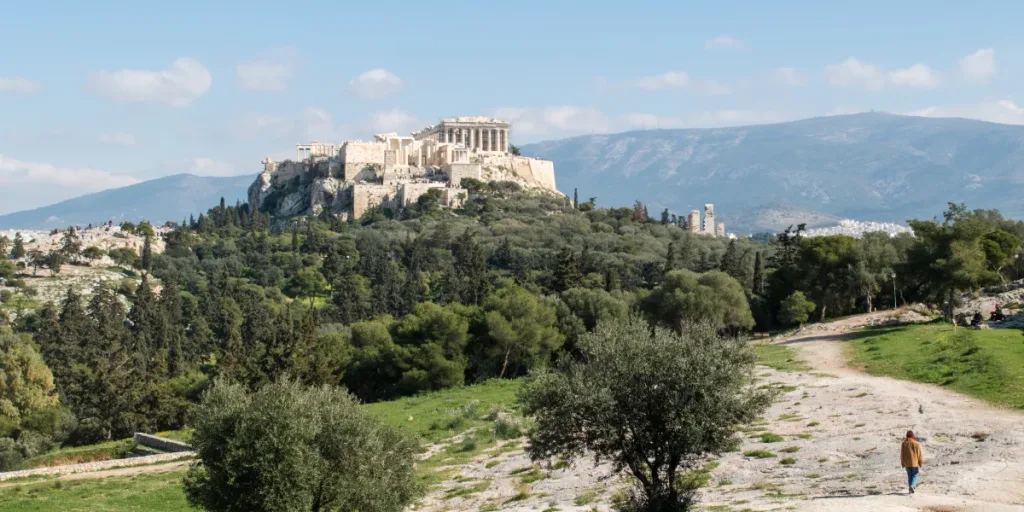The Areopagus Hill in Athens: A Witness to History and Contemplation

In the heart of Athens, amidst the ancient ruins and modern cityscape, the Areopagus Hill, also known as Mars Hill, stands as a silent witness to millennia of history, philosophy, and contemplation. This iconic landmark holds a special place in the collective memory of Athens, offering both breathtaking panoramic views and a profound connection to the city’s past.
A Geological Wonder
The Areopagus Hill is a rocky outcrop that rises roughly 115 meters (377 feet) above sea level, overlooking the city of Athens. Its unique geological formation, consisting of limestone and conglomerate rock, makes it a distinctive feature in the Athenian landscape. The name “Areopagus” is derived from the Greek word “Areios Pagos,” which means the “Hill of Ares” or the “Hill of Mars,” named after the god of war. In antiquity, the Areopagus Hill served as an important center for the administration of justice and law. It was here that the Areopagus Council, one of the most powerful judicial bodies in ancient Athens, convened to preside over criminal cases, including matters related to homicide. The council was revered for its wisdom and impartiality, and it played a crucial role in maintaining order and justice in the city-state.
A Place of Historical Significance
One of the most notable events associated with the Areopagus Hill is the legendary trial of Socrates in 399 BC. The great philosopher was brought before the council and charged with impiety and corrupting the youth of Athens. Socrates’s defense and subsequent sentencing to death by drinking hemlock are among the most iconic episodes in the history of philosophy. Today, visitors can stand on the same ground where Socrates once defended his philosophical ideals. One of the most compelling reasons to visit the Areopagus Hill is the panoramic view it offers of Athens and its surroundings. From this vantage point, visitors can marvel at the sprawling city below, with its iconic landmarks such as the Acropolis, the Ancient Agora, and the Temple of Hephaestus. The hill provides an ideal spot for capturing memorable photographs and gaining a deep appreciation for the city’s historical and architectural beauty.

A Place for Contemplation
The panoramic view from the top of the Areopagus is simply breathtaking. Athens stretches out at your feet, with the majestic Acropolis dominating the landscape. The modern city blends with the vestiges of its glorious past, creating a unique contrast between the ancient and the contemporary. The atmosphere on the hilltop is calm and solemn, making it an ideal place for contemplation. Visitors can sit on the time-worn rocks and simply observe the world around them. It is a place that invites meditation and reflection on the greatness of Greek civilisation, its contribution to philosophy, art and democracy, as well as the importance of justice and wisdom in society.
Accessibility and Preservation
Ensuring that the Areopagus Hill is accessible to all individuals, regardless of their physical abilities, is of paramount importance. It is a historical and cultural site that holds significance not only for Greece but for the world. Therefore, it should be made accessible to people with disabilities. This means creating wheelchair ramps, ensuring that pathways are well-maintained and even, and providing appropriate signage and information for those with visual or hearing impairments. Accessibility initiatives can include the installation of handrails, accessible restrooms, and seating areas for those who need them. Making the site inclusive ensures that everyone, irrespective of their physical limitations, can experience its historical and cultural significance. Preserving the Areopagus Hill is vital to maintain its historical and cultural value for future generations. Preservation efforts must be carefully balanced with the need to make the site accessible. Preservation can involve activities such as maintaining the structural integrity of any ancient ruins or artifacts, preventing erosion, and protecting the natural environment surrounding the hill. This could also include measures to control visitor numbers to prevent over-tourism and to safeguard against potential damage to the site. Conservationists and archaeologists play a crucial role in preserving the historical integrity of the site, ensuring that it remains a genuine representation of its ancient past. Preservation efforts should be guided by international standards for heritage conservation to ensure that the Areopagus Hill remains a cultural treasure for the ages.

Conclusion
The hill of the Areopagus in Athens is a beacon of knowledge, history and contemplation. It is a place where past and present intertwine in an eternal dance of reflection and learning. Every visit to this special site is a reminder of the importance of our cultural roots, of the relentless pursuit of knowledge and truth, and of the need to preserve these treasures for generations to come. The Areopagus Hill is a place where time stands still, and where we can connect with the essence of ancient Greece while admiring the views of the modern city. It is a reminder that history is alive, that culture endures, and that contemplation and reflection remain powerful tools for human growth.








